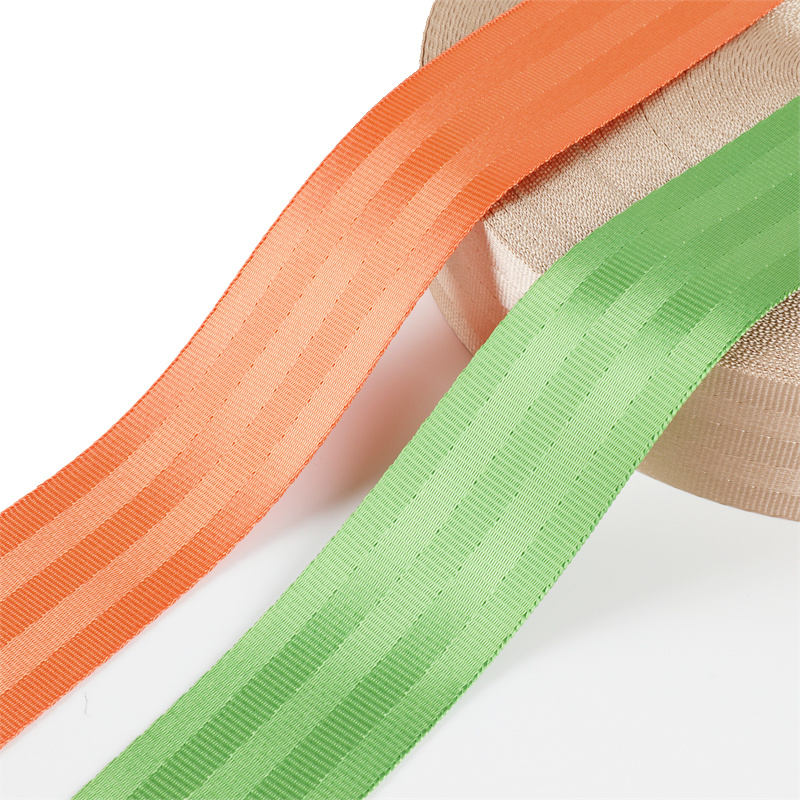Top 10 Outdoor Webbing Applications for DIY Enthusiasts
Top 10 Outdoor Webbing Applications for DIY Enthusiasts
Introduction to Outdoor Webbing
Outdoor webbing is a strong, durable material made from nylon, polyester, or other synthetic fibers. It is commonly used in various applications due to its high tensile strength, resistance to wear and tear, and weather durability. This guide will explore the **top 10 applications** for outdoor webbing, provi
Jul 14,2025

Top 10 Outdoor Webbing Applications for DIY Enthusiasts
Introduction to Outdoor Webbing
Outdoor webbing is a strong, durable material made from nylon, polyester, or other synthetic fibers. It is commonly used in various applications due to its high tensile strength, resistance to wear and tear, and weather durability. This guide will explore the **top 10 applications** for outdoor webbing, providing **DIY enthusiasts** with valuable insights into how to effectively use this versatile material in their projects.
Table of Contents
1. Understanding Outdoor Webbing
2. Benefits of Using Outdoor Webbing
3. Top 10 Applications of Outdoor Webbing
3.1. Camping Gear and Accessories
3.2. Outdoor Furniture Construction
3.3. Pet Leashes and Harnesses
3.4. DIY Hammocks
3.5. Secure Outdoor Storage Solutions
3.6. Fashionable Outdoor Gear
3.7. Paracord Projects
3.8. Climbing and Mountaineering Equipment
3.9. Garden Trellis and Plant Support
3.10. Emergency Preparedness Gear
4. Choosing the Right Type of Webbing
5. Tips for Working with Outdoor Webbing
6. Frequently Asked Questions (FAQs)
7. Conclusion
1. Understanding Outdoor Webbing
Outdoor webbing is a type of flat, woven fabric that comes in various widths and colors. It is primarily used for its strength and flexibility. Commonly made from materials such as nylon and polyester, outdoor webbing is resistant to UV rays, moisture, and wear, making it an ideal choice for various outdoor applications. Its lightweight nature allows for easy handling, while its high tensile strength ensures reliability in demanding situations.
2. Benefits of Using Outdoor Webbing
Outdoor webbing offers a multitude of benefits for DIY enthusiasts. Here are some key advantages:
- **Durability**: Made from synthetic fibers, outdoor webbing withstands harsh weather conditions, ensuring longevity in your projects.
- **Versatility**: Its applications are diverse, ranging from camping gear to fashion accessories, making it a valuable material for various DIY projects.
- **Customizability**: Outdoor webbing is available in numerous colors and patterns, allowing you to personalize your projects.
- **Lightweight**: The lightweight nature of webbing makes it easy to carry and maneuver, perfect for outdoor adventures.
- **Cost-Effective**: Compared to other materials, outdoor webbing is generally affordable, making it accessible for DIY enthusiasts on a budget.
3. Top 10 Applications of Outdoor Webbing
Now that we understand the basics, let's explore **the top 10 outdoor webbing applications** that DIY enthusiasts can implement in their projects.
3.1. Camping Gear and Accessories
Outdoor webbing is an essential component of camping gear, including tent straps, storage bags, and backpack straps. Its strength ensures that your equipment remains secure during your adventures. You can create custom gear by sewing webbing onto your existing camping accessories, enhancing their functionality and durability.
3.2. Outdoor Furniture Construction
One of the most popular applications of outdoor webbing is creating comfortable, weather-resistant outdoor furniture. DIY enthusiasts can use webbing to construct lounge chairs, hammocks, and even patio tables. By weaving webbing through a sturdy frame, you can create stylish and functional furniture that withstands the elements.
3.3. Pet Leashes and Harnesses
For pet owners, outdoor webbing is an excellent material for making customized leashes and harnesses. The strength of the webbing ensures that your furry friends remain safe and secure during walks and outdoor activities. You can personalize these items with different colors and patterns, adding a touch of flair to your pet's outdoor gear.
3.4. DIY Hammocks
Hammocks are a favorite among outdoor enthusiasts, and making your own can be incredibly rewarding. Using outdoor webbing, you can create a sturdy, comfortable hammock that holds up to outdoor conditions. Simply attach webbing to the ends of your fabric, secure it to trees or posts, and enjoy your homemade relaxation spot.
3.5. Secure Outdoor Storage Solutions
Outdoor webbing can help secure storage solutions in your garden or yard. Use it to create straps for securing tarps, covers, or storage bins. By weaving webbing into your outdoor storage projects, you’ll ensure that your items remain safe from the elements while maintaining easy access.
3.6. Fashionable Outdoor Gear
Beyond practical applications, outdoor webbing can be used to create trendy outdoor gear such as belts, bags, and wallets. The unique texture and colors of webbing allow for creative designs that can be both functional and fashionable. With a little creativity, you can craft eye-catching items that make a statement in any outdoor setting.
3.7. Paracord Projects
Paracord is another popular material among DIY enthusiasts, and when combined with outdoor webbing, the possibilities are endless. You can create survival bracelets, keychains, or even decorative items using a combination of paracord and webbing. These projects not only provide utility but also showcase your skills and creativity.
3.8. Climbing and Mountaineering Equipment
For those who enjoy climbing or mountaineering, outdoor webbing is essential for creating slings, anchor systems, and other safety equipment. Its high tensile strength makes it a reliable choice for securing gear and ensuring safety during outdoor adventures. Understanding how to properly use webbing in climbing applications is crucial for safety and success.
3.9. Garden Trellis and Plant Support
Using outdoor webbing for garden trellises and plant support is an innovative way to enhance your garden. By creating trellises with webbing, you can provide support for climbing plants while adding an aesthetic element to your garden. The durability of webbing ensures that your plants have the support they need to thrive.
3.10. Emergency Preparedness Gear
Outdoor webbing can be a vital component of emergency preparedness gear. You can create straps for securing items during travel or emergency kits that require sturdy attachments. The versatility of webbing allows for creative solutions to ensure that you are well-equipped for unexpected situations.
4. Choosing the Right Type of Webbing
When selecting webbing for your projects, it’s essential to consider the type that best suits your application. Here are some factors to keep in mind:
- **Material**: Nylon webbing is strong and elastic, making it great for outdoor gear, while polyester webbing is UV resistant and ideal for sun-exposed applications.
- **Width**: The width of the webbing affects its strength and application. Wider webbing distributes weight more evenly, making it suitable for heavier loads.
- **Color and Pattern**: Choose colors and patterns that align with your personal aesthetic or the theme of your project. Bright colors can also enhance visibility in outdoor settings.
5. Tips for Working with Outdoor Webbing
Here are some tips to help you effectively work with outdoor webbing:
- **Use the Right Tools**: Scissors, sewing needles, and thread designed for heavy-duty use are essential for crafting with webbing.
- **Sewing Techniques**: When sewing webbing, use a strong stitch such as a zigzag or box stitch to ensure durability.
- **Avoid Fraying**: Seal the edges of the webbing with heat or fabric sealant to prevent fraying and prolong the life of your projects.
- **Test Load Capacity**: If your project involves bearing weight, always test the load capacity of the webbing before use to ensure safety.
6. Frequently Asked Questions (FAQs)
**Q1: What is outdoor webbing made of?**
A1: Outdoor webbing is typically made from strong synthetic materials such as nylon or polyester, providing durability and resistance to weather conditions.
**Q2: Can I wash outdoor webbing?**
A2: Yes, you can wash outdoor webbing. Use mild soap and water, and avoid harsh chemicals that could damage the fibers.
**Q3: How do I choose the right webbing for my project?**
A3: Consider the application, weight capacity, and environmental factors when selecting webbing. Nylon is best for flexibility, while polyester is ideal for UV resistance.
**Q4: Is outdoor webbing suitable for marine applications?**
A4: Yes, some outdoor webbing is designed specifically for marine applications, offering resistance to saltwater and UV rays.
**Q5: How can I prevent my webbing from fading in the sun?**
A5: Choose UV-resistant webbing and store your projects in shaded areas when not in use to minimize fading.
7. Conclusion
Outdoor webbing is a versatile and indispensable material for DIY enthusiasts. By exploring its various applications—from camping gear to garden support—individuals can enhance their outdoor experiences while unleashing their creativity. Whether you are crafting practical items or stylish accessories, understanding how to work with outdoor webbing opens up a world of possibilities. Embrace the creativity that outdoor webbing offers and start your next DIY project today.
Related Posts
Contact Us
E-mail:
Phone/WeChat:
Factory Address:
No. 601 ShiXing Road, Jimei District, Xiamen, 361024, China







